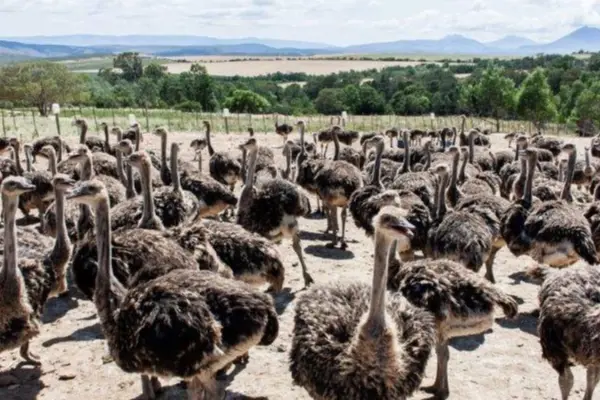Ostrich Breeder Nutritional Guidelines
If one does not take care regarding the handling, housing and nutrition of breeding birds it may lead to a decline in the production of eggs and the hatching percentage. It is also important to consider the age of the breeders Males reach sexual maturity at the age of 42 months and females are sexually mature at 30 months old. It is advisable that ostriches are used for reproduction purposes from these ages on respectively. The fertility of younger birds will be lower than older more mature birds.

Although the genetics of breeders are very important, environmental circumstances and the ration birds receive while they are growing up is also very important. If breeders are supplied with a good balanced ration and experience favourable environmental circumstances, they will perform closer to their genetic potential.
By supplying a balanced diet with optimal specifications, amino acids and minerals to breeders the following problems may be avoided:
- fertility problems
- low hatching percentage
- high chick mortality
- abnormalities of the legs and feet
General guidelines for breeding birds (figures represent an average per breeding season):
- Egg fertility percentage: 80 - 85%
- Hatching percentage (hatched/eggs packed): 60 - 65%
- Number of chicks per female: 25 - 35
- 50 - 60 eggs per female
The feeding of breeding ostriches can be divided into two distinct phases:
- The breeding season: The breeding season begins in June and can continue to January (this period is determined by the particular area, the environmental circumstances and the climate and it may therefore differ for different regions in South Africa)
- The off season: This usually occurs from February to May
Approximately four weeks before the breeding season begins one needs to start feeding a breeding ration such as the De Heus Struthio Breeder (V26572). This ration can be supplied right up to the end of the breeding season. If breeding birds are not given a maintenance ration during their off season or they receive a poor maintenance feed, it may take considerably more time to start laying eggs during the following breeding season. The reason for this is that the nutrients and/or minerals first need to be replenished before birds will begin to reproduce.
Table 1. An indication of how breeding birds should be fed throughout a year
The balance of the nutrients of the breeding ration is extremely important. Energy and protein and/or amino acid levels, such as lysine and methionine, which are vital to the development of eggs, that are too low or an imbalance of nutrients can cause problems such as a delay to the beginning of the brooding season or less eggs being laid by a female. If the levels of these substances are too high, it may cause sterility.
Mineral ingestion is also critically important because certain minerals interact with one another. An example would be calcium levels that are too high in male birds. Because one wants to ensure that enough calcium is fed to female birds, it may happen that male birds may ingest too much calcium. Calcium and zinc together form an interaction which leads to a decline in the availability of zinc. Zinc has an important role regarding sperm development and therefore the imbalance can cause lower fertility in male ostriches.
The Struthio range of feeds is specifically formulated to comply with all these requirements and it includes a premix containing the required amounts of vitamins, minerals and amino acids to aim for optimal production levels.
In addition, De Heus only uses high quality tasty raw materials to produce its feeds in order to ensure that ostriches do eat their product and also to ensure that mycotoxins are not present in their feeds. The purpose of these feeds is to ensure a tasty balanced ration at every peck.

